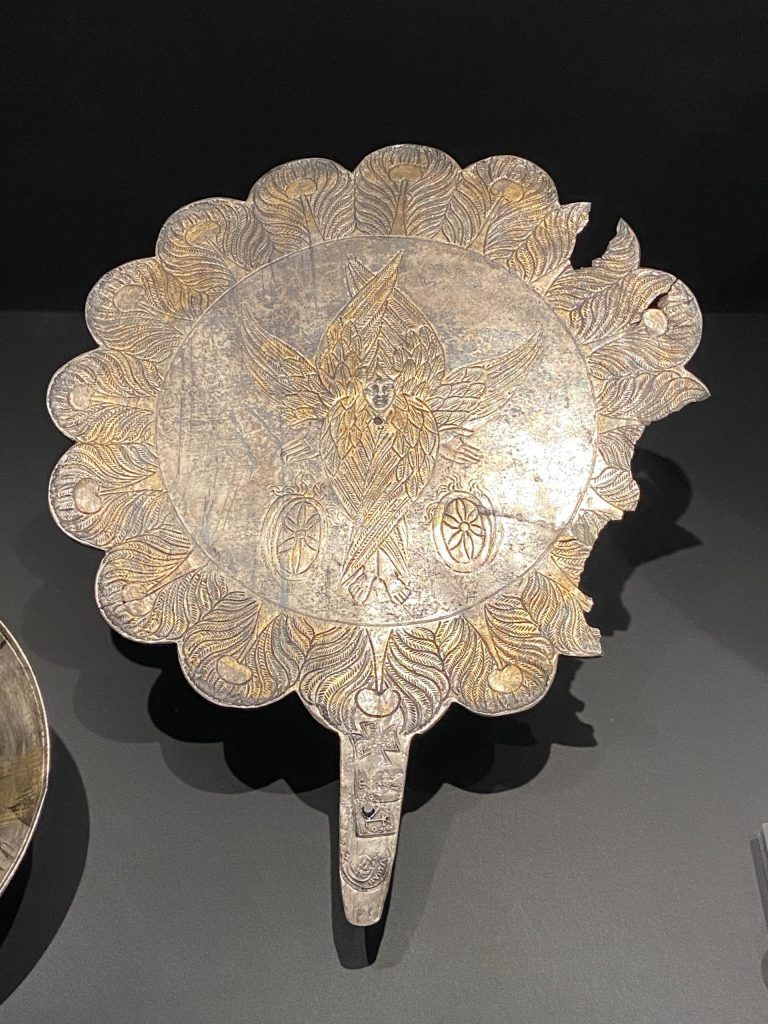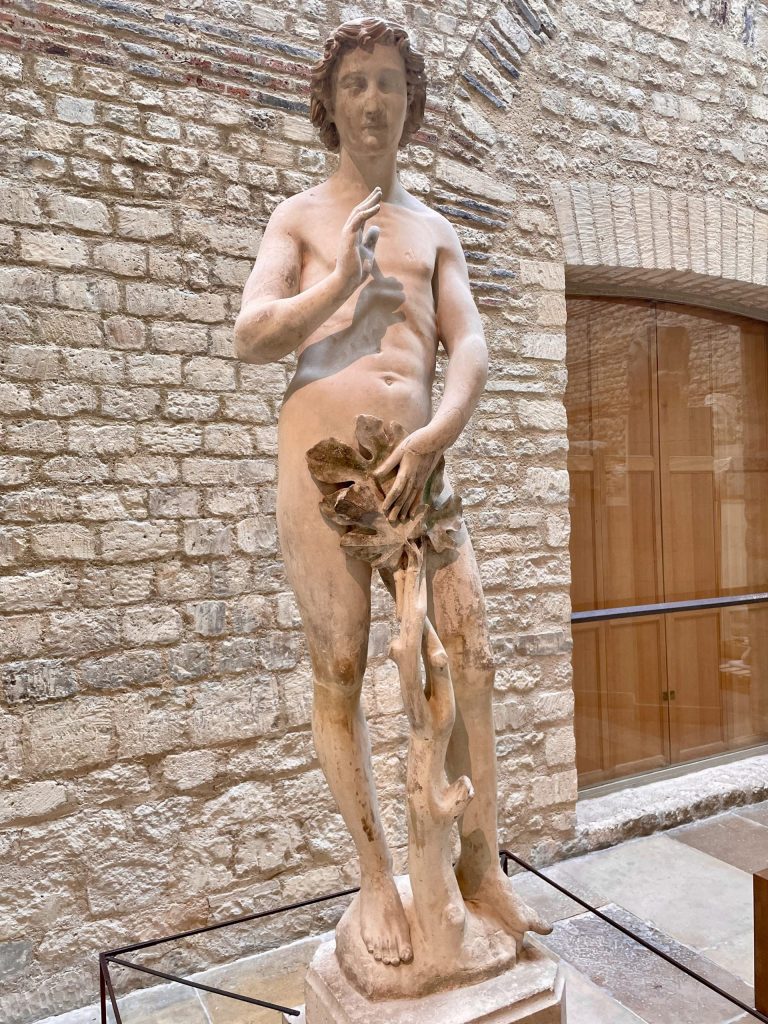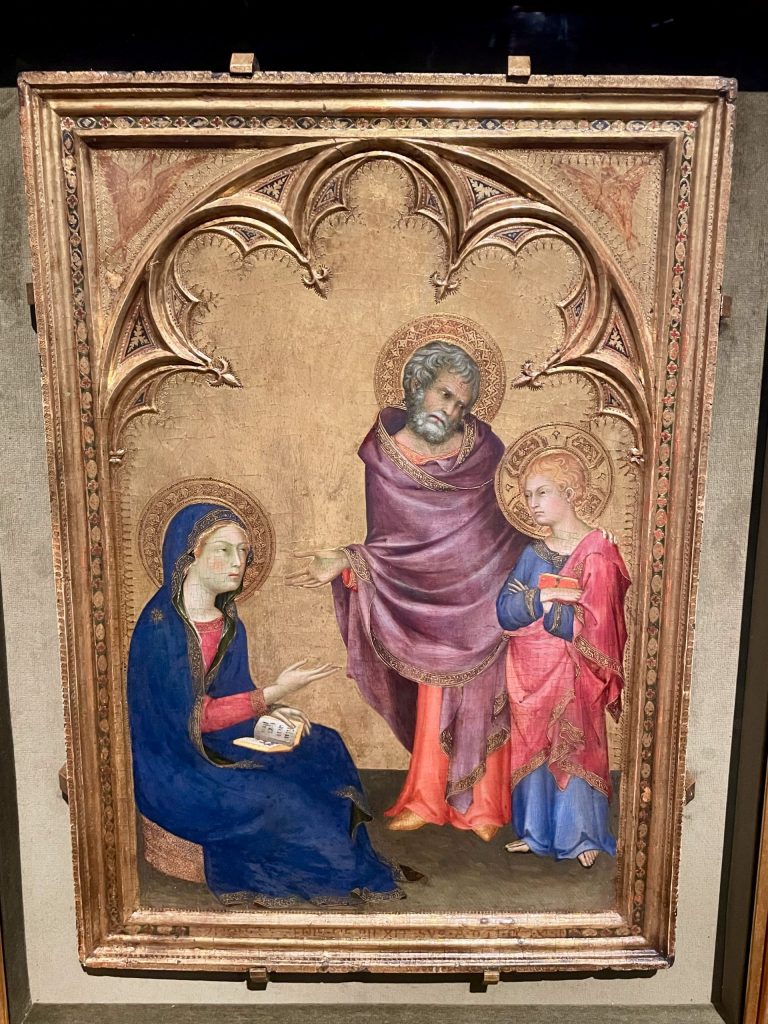Derrick Austin is the author of Tenderness (BOA Editions, 2021), winner of the 2020 Isabella Gardner Poetry Award, and Trouble the Water (BOA Editions, 2016). His third collection, This Elegance, is forthcoming in Spring 2026. A Cave Canem fellow, he is the recipient of a Ron Wallace Poetry Fellowship, a Stegner Fellowship, and an Amy Lowell Poetry Traveling Scholarship. He has had poems and essays commissioned by The Madison Museum of Contemporary Art, The New Museum, Craft Contemporary, The Jule Collins Smith Museum of Fine Arts, The Brick (formerly LAXART), and The Museum of Contemporary Art Los Angeles.
Recommended citation: Derrick Austin, “Medieval Ekphrasis,” Different Visions: New Perspectives on Medieval Art 11 (2025). https://doi.org/10.61302/PLUZ7100.
Visiting American museums, I’ve found medieval galleries tend to be one of the quietest and least trafficked. All that allusion, maybe. All that blood. All that Jesus—and not the sculpted, Renaissance Jesus but more difficult depictions at once too otherworldly and too bodily. I’m amazed by people who have an easy intimacy with the divine. As a Black, homosexual given to bouts of depression in a profoundly anti-Black and homophobic country, intimacy has often been fraught. Love has never been easy or simple. And isn’t Jesus Love itself?
Last spring, I visited The Cloisters for the first time in nearly a decade. The city had been strangely cold that week but on our walk the sun was bright and hot. My friend had never been before. We called it our pilgrimage. In the Cuxa cloisters, we took pictures of each other taking pictures of flowers. There were tulips the color of dry wine that I loved best. On plain tables, there were cuttings of plants commonly grown in medieval gardens. Some poisonous species grew in nearby pots.
The Unicorn Tapestries were woven in the late fifteenth and early sixteenth centuries. The unicorn poses, flees, thrusts, and bleeds. Each wool tapestry is large and dizzyingly detailed. We were taken by the hunters’ clothes, the time lavished on a shining boot. One of the men, turned just so as if to flaunt his sleeve’s blue folds, charmed us. Look at me, he said. See me here in this moment in the world.

Even when I’m not writing about visual art, it informs my poems. I have a passion for art, particularly religious works and European paintings. I delight in their beauty. I’m awed by the labor required to create these objects. They refine my thinking about poetic form. What I love best about ekphrasis (writing about visual art) is that it’s an encounter between the viewer and the object. The ekphrastic poem isn’t the painting, it’s the space between, where the viewer brings to bear their history and position in the present with the history of that painting. The poem is what can’t be seen.
In an interview with The Paris Review, Anne Carson reflects on churchgoing despite not being particularly devout: “A kind of thinking takes place there that doesn’t happen anywhere else.” Looking at Simone Martini, for example, my mind feels liberated. When I’m in a quiet gallery, attentive to an artwork, not rushed, letting my mind wander and wonder, I feel a physical charge that I imagine must be what people feel when they pray. I didn’t grow up going to church. I don’t have a regular spiritual practice, but I’m still invested in the questions religious belief raises. I think they’re worthwhile questions because often, distilled, they are questions of intimacy, selfhood, origin, and power. We all seek after answers. Poems rarely answer anything for me, but they’re an excellent engine for questions and supposition.
My poem “Catacombs of San Callisto” is a poem of queer intimacy and devotion between sightseeing lovers. Those catacombs contain some of the earliest Christian art when depiction was slippery and vexed, when Jesus was a beardless youth like Apollo. “Byzantine Gold” unfolds beneath the authoritative eyes of Christ Pantocrator. I’ve desired men with those eyes. I like that Jesus can be hieratic and distant. I like that Jesus can have a physical body like ours, a beautiful body, a wounded body. I like that depictions of Jesus can be sensual and weird and frightful and opaque. I’m awed by medieval artists, their thorny and intelligent designs.

Illumination
Witness the monk
tracing figures
on bright, empty pages.
Shine and color rise
like mist
in meticulous outlines,
his path illumined by
a dribbling candle
Wanton overgrowth,
spriraling arabesques,
the works of his
hands blossom
on both pages: split pomegranates
(cinnabar pigment,
iron rich), a lattice
of jade leaves (lapis worth more than
a year’s wages)
and rose gold shocks
of bougainvillea. His garden
is the centerpiece.
Hares and falcons
and the gentle flick of
his brush,
white for a hind’s tail;
cows graze flat fields (perspective
as yet unknown).
And all these are named,
as when Adam reared and ranked
their tribes,
for a prince’s solitary pleasure,
each beast and blossom.
Every page gilded
as if to pollinate
those fingertips. And this
is but one page, one page
in a book of praise.
The monk inks the owner’s likeness
in a green cloak
lined with gold leaf
to echo the landscape
(the body politic
easy parable for a boy). But this garden
is very real. See there,
how the monk
bearded and wiry, inserts himself
and points to the adjacent page?
A flaming sword.
Two figures
evicted from their green shade.
The vellum
supple as with her tears.
Both cover their nakedness
with a banner,
he holds the word humus
and she, hubris.
Written
on the flesh.
The ash and soot of a
book burning
just under her foot
as if ruin made our shadows.

Fan, Silver, 6th century CE, Aleppo (Syria), Istanbul Archaeological Museum.
Imagine the pages of illuminated manuscripts turned by an anxious lady or penitent lord. Knowledge worth its weight in gold and precious stones. Imagine reaching for a fan on a sleepless, summer night. A seraph visible in moonlight.
Catacombs of San Callisto
He’s never Himself in the earliest frescos:
the shepherd boy guarding the sallow lamb
whose fleece might hide the god. Or the fish
and bowl of loaves. Or the phoenix.
He isn’t Himself, yet I trust Him.
I’ve walked alone with a man in the dark
and made much of his body—
you’re with me now, touring the nests of the dead.
We’re told by books old as these walls:
Filthy, our bodies, yours and mine. Not so.
When we love, we take each other in
like living water until warm
plaits of air unbraid in our throats.
The early artists did not turn up their noses
to flesh and, in this way, honored
the putrefying bodies in their midst
and painted the signs by which their bodies
would be watched and known.
The liquid issue smeared the frescos
with scents of urine and blood.
I would gladly shame myself in this way for you.
I would be the good shepherd
above your body in its cold, stone niche
not only because I believe
in the resurrection of the body, but because
I want to be the face that welcomes you
to that inordinate dark.

Adam, lle-de-France, about 1260, Lutetian limestone, traces of polychromy From Notre-Dame de Paris, reverse of the southern facade of the transept, Musée de Cluny.
Shame seems utterly absent from this Adam’s world even while clutching the cartoonish leaf. It’s wholly medieval yet it echoes the Classical past. He reminds me of Milton’s Adam in Paradise Lost, a sweet fool.
Byzantine Gold
A chain of blue-white chips mimics waves
pleating
around Christ’s body. Owl-eyed saints
draw light on the western wall.
Despite
centuries of votive smoke,
the shining ranks of prophets gesture,
elegant
as sommeliers, toward mosaic scrolls
and would have you consider the honeycombed
geometry
of paradise—dome, arch, and column—
with its air of permanence,
above penitent
and tourist, above the fray
of ethnic cleansing we’d like to believe:
a Balkan
landmine planted near trillium,
the scarred field, the ghost limbs of olive trees,
and the boy
there, I mean, he’s a man now,
about my age, passing us on his prosthetic leg—
that which was
sundered brilliantly shining—though
he might have been a child when he lost the limb.
Think invention.
Think miracle. To think someone, Doctors
Without Borders, maybe, could make a man whole again.
But look:
a mortar leveled Gethsemane,
Visigoths defaced the deposition, and,
her turquoise
hem unraveling, poor Mary’s going to pieces,
pocked by shrapnel from a mislaid bomb.
If the dome
cracked open, what a dry comb it would be.
We consider paradise anew despite its stone
indifference
to time. Christ Pantocrator, alien, severe,
claims the apse, suspended in gold
leaf, apart
from and a part of the world, the dust
those semi-precious stones become. We would find
comfort
in his Renaissance flesh,
its bordello-shades of pain—the oils
of the canvas
like the oils of the body—but where
would we find warmth beneath these glass eyes,
radiant,
petrifying? His gaze arrests us
like everything we make, which is touched
with our image:
metals and mirroring glass
in mortal shapes, even the minefield,
visionary
in its violence—God before Sodom
would be amazed by such force. The mind
itself
drips rough honey and gilds the world.

Christ Discovered in the Temple, painted in 1342, Simone Martini (about 1284-1344), Tempera on wood panel, Walker Art Gallery, Liverpool.
Simone Martini, renowned for his elegant forms, is perhaps my favorite painter of the Virgin Mary. He often depicts Mary’s all-too-human agitation. I laugh looking at Mary and Joseph in this intimate panel painting because parents have been giving that same disciplinary look for centuries. In a field of gold indebted to Byzantine icons, Martini renders the sacred world of the Gospels with psychological precision and good humor.
Art Restorer
What are these figures up to? Who knows.
It’s hard to read a weathered expression.
In an apron, I arrange my tools in rows:
cotton swabs to clean faded, celestial hose,
a scalpel for wax on a distant mountain.
What are these figures up to? Who knows
if angels can curse or grieve Golgotha’s woes.
Leading our gaze, accessories to Magdalene
and Christ, they show us what to feel. Suppose
they look like us, their faces a lost reflection?
What are these figures up to? Who knows.
The panel cracked from heat. An x-ray shows
patterns in the wood I preserve or recondition.
Picture its candlelit past: a draft blows
against chafed pilgrims wrapped in sheepskin.
Recovering the shades and shadows
of different eras and other worlds, I imagine
I do good work here. At last, this corner glows.
Centuries of varnish dissolve. Sickly yellows
leave Mary’s face. Her eyes are wet and sanguine.
originally published in American Literary Review

Fragment of a hanging representing the god Dionysos under an arch (detail), Egypt, Late Roman-Early Byzantine Period,
4th-early 5th century, Tapestry weave of dyed wools and undyed linen, MFA Boston.
And sometimes the past can’t be restored. This is no problem for the god of wine and ecstasy. Still he dances separated from his feet.
